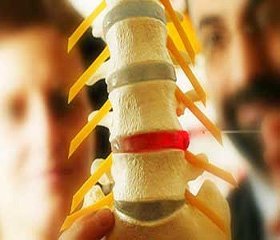Международный неврологический журнал 8 (70) 2014
Вернуться к номеру
Clinical and Diagnostic Features of Vertebrogenic Vertebral Artery Syndrome in Patients with Epilepsy
Авторы: Shebatin A.I. - Municipal Institution «Regional Clinical Mental Hospital», Zaporizhzhia, Ukraine
Naumova I.I. - Budgetary Institution of Chuvash Republic «Novocheboksarsk City Hospital» of the Ministry of Health and Social Development of the Chuvash Republic, Novocheboksarsk, Russia
Рубрики: Неврология
Разделы: Клинические исследования
Версия для печати
Diagnosis of vertebrogenic vertebral artery syndrome (VAS) in patients with epilepsy — difficult task. Objective: description of diagnosing VAS in patients with epilepsy. Material. Survey data of 5 patients with temporal lobe epilepsy are described. Subjective symptoms, objective research data are provided. Eye retraction syndrome was a significant sign in VAS diagnosis, its severity in each case is individual and has been changed after stimulation of the vertebral artery. An overview of instrumental examination in this group of patients is given. Thus, use of eye retraction syndrome significantly improves the diagnostic process and enables proper treatment.
vertebral artery syndrome, eye retraction syndrome, epilepsy.
Significant task when meeting with the patient, is the diagnosis of pathological process. Often there is not a single disease, and if one pathology is quite pronounced, and the other is in its shadows, its diagnosis is difficult. Pathology of epilepsy is bright, and it is difficult to determine the background of other conditions if they manifest headache, dizziness. Epilepsy itself accompanied by headache in 59 % of cases [20]. With temporal lobe epilepsy, headache was observed between attacks in 80.4 % of cases [10]. Often in epilepsy paroxysmal headache, migraine indicates [1, 7, 13]. The literature describes the combination of epilepsy and vertebral artery syndrome[13]. The article focuses on the vertebral artery syndrome, in the soviet literature functional stage wellness, cervical migraine, Leu–Barre syndrome, posterior cervical sympathetic syndrome in ICD –10 class section XIII M53, M53.0 Neck sub — cranial syndrome (posterior cervical sympathetic syndrome). vertebral artery syndrome in epilepsy diagnosis is not possible by relying on subjective symptoms. Radiological changes in the cervical spine, just are not signs vertebral artery syndrome[16]. Doppler indices during the functional test is also not a reliable indicator of compression the vertebral artery [14]. And the only way to diagnose is the method proposed by A. Shebatinym. Identifying symptoms of retraction of the eyeball during stimulation of the vertebral artery [18]. The purpose of the description of diagnostic capabilities vertebral artery syndrome in patients with epilepsy.
Materials and methods. The material was compiled study of 5 patients with temporal lobe epilepsy, middle age 42,2 ± 6,576 years. Neurological examination with compulsory de Klein tests horizontal eye movement during the inspection prior to the trial and after the trial.
Results and discussion. In interparaxysmal period there have been complaints, some of which were clinical picture and spa. A common complaint was headache in 3 cases, diffuse across the head, in two cases, by gemitipe. Complaints of dizziness were in all cases, under form of non–systemic swinging objects, while patients have experienced difficulty in walking, in one case, along with non–systemic vertigo mentioned system. Tinnitus 4 casesin 2 cases, the blackout in 2 cases the complaint of feeling cold snap the upper extremities, and in 2 cases of numbness. In two cases, the complaints of pain at heart, whining complaint in 1 case, in the mood decrease in 2 cases, a feeling of lack of air in 1 case. All patients complained of recurrent pain in the cervical spine. Objective: 2 cases of horizontal nystagmus, all positional nystagmus. Symptom retraction of the eyeball was absent in 1 case, 3 cases of low–grade left, and 1 case of poorly defined with 2 sides. After a trial in 2 cases is symptomatic with 2 sides, 1 in a one–sided much pronounced in 2 cases less pronounced on the left and the right, while in 1 case after the test has increased nystagmus and vertigo appeared. Reflex with limb asymmetry observed in 1 case. Magneto– rezonanstaya tomography of the brain, 2 cases of variant of the norm, 2 case of symmetrical hydrocephalus, 1 case of symmetrical hydrocephalus and symptoms of empty sella. X–ray of the cervical spine: All the signs of degenerative disc disease of the cervical spine instability with signs of spinal motion segments in the lower cervical spine in two cases marked by instability, and in the middle section. Duplex scanning of the carotid without pathology department. Research vertebral artery: the research presented at the vertebral artery table № 1.
The patient in the case 5, along with epilepsy and vertebral artery syndrome, occurred vertebral– basilar insufficiency, which confirms the clinical picture and doppler sonography study. The changes presented in the 6th column, are not as reliable in the diagnostic plan. [14] Thus, summarizing the article, it should be noted that the vertebral artery syndrome is not the most common comorbidity of epilepsy, but such cases are found and need to remember that. The clinical picture vertebral artery syndrome is not always fit into the well–known diagnostic criteria. Certain difficulties arise in collecting these subjective symptoms. The results of instrumental studies are not specific and specific to the vertebral artery syndrome. The only objective evidence, enabling them to diagnose the vertebral artery syndrome, is a symptom of a retraction of the eyeball.
Conclusion. Diagnostics vertebral artery syndrome much easier, and it becomes timely patient with epilepsy when using an objective diagnostic symptom , the symptom of a retraction of the eyeball, and resulting adequate treatment of the patient reduces his suffering and financial costs on inadequate therapy.


/15/15.jpg)